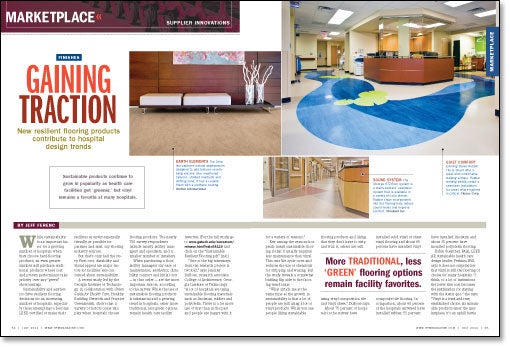Gaining traction

While sustainability is an important factor for a growing number of hospitals when they choose hard-flooring products, an even greater number still purchase traditional products whose cost and proven performance take priority over any "green" shortcomings.
Sustainability and aesthetics drive resilient flooring decisions for an increasing number of hospitals, especially those attempting to become LEED certified or make their facilities as environmentally friendly as possible for patients and staff, say flooring industry sources.
But that's only half the story. First cost, durability and visual appeal are major factors for facilities less concerned about sustainability.
A recent study led by the Georgia Institute of Technology, in collaboration with Green Guide for Health Care, Healthy Building Network and Practice Greenhealth, shows that a variety of factors come into play when hospitals choose flooring products. The nearly 700 survey respondents include mostly facility managers and specifiers, and a smaller number of installers.
When purchasing a floor, facility managers say ease of maintenance, aesthetics, durability, comfort and initial cost — in that order — are the most important factors, according to the survey. While the use of sustainable flooring products is substantial and a growing trend in hospitals, other more traditional, less green options remain health care facility favorites. (For the full study, click here and click on the "Sustainable ResilientFlooring.pdf" link.)
"One of the big takeaways from the research project is twofold," says Jennifer DuBose, research associate, College of Architecture, Georgia Institute of Technology.
"A lot of hospitals are using sustainable flooring materials such as linoleum, rubber and polyolefin. There is a lot more use of that than in the past and people are happy with it for a variety of reasons."
Key among the reasons hospitals install sustainable flooring is that it usually requires less maintenance than vinyl. This cuts life-cycle costs and reduces the use of chemicals for stripping and waxing. But the study reveals a somewhat baffling flip side to the flooring trend issue.
"What struck me at the same time as the growth in sustainability is that a lot of people are still using a lot of vinyl products. While you see people liking sustainable flooring products and liking that they don't have to strip and wax it, others are still using vinyl composition tile and vinyl sheet," DuBose says.
About 75 percent of hospitals in the survey have installed solid vinyl or sheet vinyl flooring and about 65 percent have installed vinyl composite tile flooring. In comparison, about 60 percent of the hospitals surveyed have installed rubber, 55 percent have installed linoleum and about 25 percent have installed polyolefin flooring.
Robin Guenther, FAIA, LEED AP, sustainable health care design leader, Perkins+Will, says it does not surprise her that vinyl is still the flooring of choice for many hospitals. "I think, to a lot of institutions the lower first cost becomes the justification for staying with the status quo," she says. "Vinyl is a tried-and-true, established choice. As sustainable products enter the marketplace, it's an uphill battle against the incumbent."
"There's a great deal of vinyl composite tile used in hospitals for one reason — cost," says Ron Tait, national sales manager, Flexco Corp. (www.flexcofloors.com), Tuscumbia, Ala. "It is a far less expensive product up front."
Vinyl has other advantages compared with the more sustainable alternatives. It comes in a wider array of designs and colors than more sustainable options, which helps hospitals achieve the look of home or a hospitality facility. Nearly 40 percent of managers who responded to Georgia Institute of Technology's survey rank aesthetics as an important factor in choosing hard flooring, the second most commonly chosen attribute.
"Aesthetics are definitely important," says Jeremy Salomon, product manager, Tarkett (www.tarkett.com), Chagrin Falls, Ohio, which offers both linoleum and vinyl products. "We notice a lot more designers and architects are involved in the process of choosing flooring."
Di Anna Borders, principal designer, Armstrong World Industries (www.armstrong.com), Lancaster, Pa., says, for the past two years, hospitals have made aesthetics a top consideration when they pick flooring. That has made sheet vinyl and luxury vinyl tile popular because of the range of colors and designs available in that material.
"Am I surprised by that? Absolutely not," Borders says. "We ask what's most important to designers to find out what are their first steps in choosing a floor. Color and design are always No. 1 or 2."
Tait agrees with Borders' observation. "People still select flooring on style and color. They're not going to put an ugly floor in a patient room just because it's easy to clean. They're still going to be looking for the aesthetic, something that's appealing, pleasing to the patient," he says.
With more hospitals emphasizing the benefits of evidence-based design, flooring will continue to play a role in providing an environment that is soothing to patients, Tait says. "I think you'll find that most hospitals now are very much in tune with how the surroundings affect the healing process of the patient. Flooring must be pleasing to the eye, comfortable, comforting."
Kate Lowry, product manager, Ecore International (www.ecoreintl.com), Lancaster, Pa., whose company makes recycled rubber flooring, also believes that aesthetically pleasing flooring contributes to patient healing as well as the overall atmosphere hospitals seek. "A growing interest in holistic wellness as well as a noninstitutional feel also lend to residential and hospitality trends," she says.
Sustainability grows
Despite the continued popularity of vinyl products, sustainable flooring materials continue to become more common in hospitals. This is especially true at health care facilities that make being green part of their mission, and where money is not as much a barrier.
Guenther says more hospitals are choosing alternative flooring materials because they offer important benefits to staff and patients that make the higher cost worthwhile.
"Those factors take occupant health and safety into account in a greater way," Guenther says. "People are finding ways to pay for more expensive flooring because of reduced maintenance cost over time and improved employee satisfaction."
For many hospitals, sustainability translates to less maintenance, thereby eliminating or reducing as many chemicals as possible for waxing, stripping and cleaning. About half of the facility managers surveyed rank cleanability as an important attribute in picking a hard-flooring product, making it the most frequently chosen factor in Georgia Institute of Technology's survey.
"Low maintenance is a tremendous factor in choosing flooring as hospitals want to get away from using caustic chemicals," says Amanda Utz, marketing director, Amtico International, Atlanta, which manufactures luxury vinyl tile with a urethane coating.
"What we're seeing is the trend toward greener, sustainable solutions," says Salomon of Tarkett, which offers linoleum, rubber and vinyl sheet products to accommodate the needs of all customers. "There's a lot more linoleum going in. There are a lot more products available that are easier to maintain and with fewer chemicals."
Tom Burns, manager for the health care and pharmaceutical industry, Stonhard Inc. (www.stonhard.com), Maple Shade, N.J., says his company's urethane resin material, which is poured and bonded to concrete, is soft underfoot. This makes it ergonomic for staff, infection resistant and highly durable, with a life of up to 50 years. No waxing or stripping are required, he says.
Denis Darragh, general manager, Forbo Flooring Systems North America/Asia- Pacific (www.forboflooringna.com), Hazelton, Pa., says Marmoleum, his company's brand of linoleum, is made from renewable resources and is commonly used in patient care areas and rooms as well as corridors. The material will last up to 30 years and is low maintenance, he says.
Lowry of Ecore says the company's recycled rubber flooring products offer ergonomic benefits including comfort underfoot for patient care staff. It also is noise absorbing and slip resistant, which makes it beneficial to patients and staff.
Similarly, Tait of Flexco says his company's sheet rubber flooring products are a popular choice for hospitals because of their ease of maintenance and ability to soften noise and increase comfort.
Those in the flooring industry agree that the reasons hospitals pick a certain product over another depend on the individual hospital, who's making the decision and which product meets the facility's needs and budget.
"It depends on the designer working on the project," Utz says. "All designers try to be good stewards when it comes to being green and sustainable. However, some favor aesthetics or a product's longevity over the sustainable aspects. It boils down to what makes sense for the individual site or project."
In the end, product performance still trumps sustainability, says DuBose of Georgia Institute of Technology. "I've been advocating sustainability for 20 years, but sustainability doesn't really move that many people. Better performance moves more people," she says.
DuBose believes that while there is a subset of people who make purchasing decisions based on "the most sustainable thing to do," she is not convinced that that alone drives markets. "What changes markets is when people say, 'I really like this product. It really works.' "
Jeff Ferenc is senior editor for Health Facilities Management.
| Sidebar - For more information |
| For further details on the flooring products featured in this month's "Marketplace" article, readers can contact the following vendors:
|



